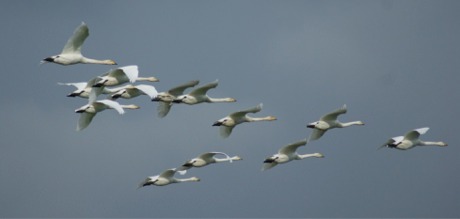|
|
The whooper has landed
24.10.11
by Linda McGrory
DAILY flights are taking off from Iceland to
Inishowen as some 1,500 whooper swans flock to their
favourite winter feeding grounds.
Ireland, north and south, supports just over half
the world population of migrating Icelandic whooper
swans at important waterways and wetlands such as
Lough Neagh, Lough Foyle, Lough Swilly, the Cashen
River and Shannon Callows.
Birdwatch Ireland said such sites are
"internationally important" feeding grounds for
whooper swans as well as Greenland white-fronted
geese, greylag geese and light-bellied brent geese.
The last Irish census of migratory swans was
undertaken in January last year - the coldest since
1985. It showed that Ireland had 14 internationally
important sites for migrating whoopers including
Lough Foyle (883) and Lough Swilly (428). |
 |
|
A majestic flock of whooper swans
arriving from Iceland to their winter feeding
grounds in Inishowen on Wednesday, October 19.
Photo: Christine Cassidy, Derry. |
It had nine nationally
important sites including the River Blackwater, Co
Meath (207); the Cull and Killag, Co Wexford (181)
and the River Moy, Co Mayo (169). The bewick swan is
a less common visitor to Ireland.
Birdwatch Ireland wetland bird specialist, Helen
Boland, said: "'Internationally importantí means
that the site supports 1 per cent or more of the
species' international population. This is a
criterion that is used across Europe for designating
sites of international significance for birds.
"Both whooper swans and brent geese are species
whose populations are doing well and have been
steadily increasing in number. Ireland is incredibly
important for both as we support the lionís share of
the entire international population of each."
Ireland's large swathes of wetland and relatively
mild climate attract some one million waterbirds
each winter from countries such as Canada, Iceland,
Greenland, Russia and Siberia.
Ms Boland also co-ordinates Birdwatch Ireland's
Irish Wetland Bird Survey which monitors the
populations of wintering waterbirds around the
country.
The last survey, in 2009, recorded 100 waterbird
species including golden plover, mallard and
oystercatcher. It showed that Lough Foyle, Dundalk
Bay, Wexford Harbour and Slobs, Dublin Bay and
Little Brosna Callows support the largest number of
migratory waterbirds. |
|

